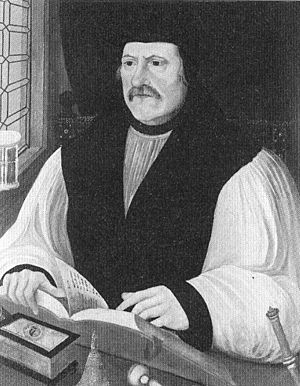Christopher Holywood facts for kids
Christopher Holywood (born 1559 – died 4 September 1626) was an Irish Jesuit priest. He lived during a time when the Catholic Church was trying to renew itself, known as the Counter Reformation. He is also linked to a famous story called the Nag's Head Fable.
Early Life and Challenges
Christopher Holywood's family came from a village near Dublin called Holywood. His family was important in both the Church and the government. He studied at Padua in Italy. In 1579, he joined the Society of Jesus, also known as the Jesuits. Later, he taught about the Bible and religion at universities in Pont-a-Mousson, Ferrara, and Padua. There, he met Saint Robert Bellarmine, another important Jesuit.
In 1598, Holywood was sent to Ireland. However, he was arrested on his way. He was held in several prisons, including the Gatehouse Prison, the Tower of London, and Wisbech Castle. After Queen Elizabeth I died, he was sent to Europe. He then continued his journey and finally reached Ireland in 1604.
That same year, he published two books in Latin that criticized the Church of England. One of these books included the first claim about an improper appointment of Matthew Parker, who was the archbishop of Canterbury. This story became known as the Nag's Head Fable. For many years, some Catholics believed this story, even though it was later shown to be untrue. Soon after, Christopher Holywood became the leader of the Jesuits in Ireland.
Jesuits in Ireland Under King James I
When King James I became king, many people in Ireland hoped for more freedom for Catholics. This feeling was very strong in Ireland. Sometimes, Jesuits even started using buildings that belonged to the Church of Ireland. Father Holywood and the other Jesuits had a lot of work to do.
When Holywood first arrived, there were only four Jesuits in Ireland. But their numbers quickly grew. By the time he died, there were forty-two Jesuits in Ireland. Another sixty were either training or teaching in other countries.
Later, the government made people take the Oath of Allegiance. This oath made people promise loyalty to the king, which was difficult for many Catholics. After this, Catholics faced difficult times. Many important families were forced to educate their children as Anglicans. Also, lands belonging to Catholics were often given to settlers from England.
Despite these challenges, Holywood continued his work. For example, a school was started in Kilkenny in 1619. This school lasted until the time of Oliver Cromwell. Five "residences," or bases for Jesuit priests, were set up. From these bases, missionaries were sent out to help people. Holywood's last report about his work was from 1624. He passed away on 4 September 1626.
Works and Legacy
Christopher Holywood wrote books that responded to other writers who disagreed with Catholic teachings. His writings were important in the religious discussions of his time. He played a key role in growing the Jesuit presence and Catholic education in Ireland during a challenging period.


